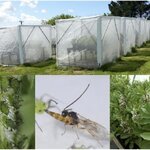Environment

A carbon tax of just $11 would offset the CO2 emissions from tourism, according to a paper in the Journal of Sustainable Tourism.
Every time people go on vacation, or journalists go off to climate conferences like the one in Paris, they are using fossil fuel energy. The total emissions from vacations like that would be the sixth largest emitter of CO2 if it were a country - five percent of total human-made emissions of CO2.
"A dangerously warming world is not in the best interest of global tourism. Many of peoples' favorite tourism destinations and activities are at risk to…

The extinction of one carnivore species can trigger the demise of fellow predators - a phenomenon called horizontal extinction cascades, where extinctions of carnivore species can have a ripple effect across species triggering further unexpected extinctions of other carnivores.
Using insects, the research team Frank van Veen, Dirk Sanders and Rachel Kehoe from the Centre for Ecology and Conservation at the University's Penryn campus in Cornwall, set up experimental communities with complex food webs in 40 four-square metre outdoor field-cages which they observed over a spring and summer…

Mexico City has the best hotel shower ever. I am not one to spend a long time in the shower, but since I have long thick hair, efficient showers are of great importance to me when on travel. So-called eco-friendly showers are doing the exact opposite of their intentions in my case. You do not have to be a physicist to understand that the difference of spending 7-8 min under fast flowing water and close to half an hour in slow flowing water results in a larger volume of water transitioning from valuable clean water to waste water. For the record, I seldom spend more than 2-3 min in the shower…

Environmental activists love to harass farmers because, let's face it, protesting farmers is safe. You never see activists protesting the far worse environmental damage done by Mexican cartels raising illegal marijuana. Dead bodies are terrible for fundraising.
But that doesn't mean the damage isn't obvious. A new study has found that the annual rate of poisoning deaths of relatively rare, forest-dwelling fishers (Pekania pennant) rose 233 percent compared to a study in 2012. The toxicants were associated with illegal marijuana farms on public and tribal lands in Northern and Southern…

Samples of permafrost soil are providing new ways to anticipate what may happen if northern regions of the world warm and begin to thaw.
Florida State University doctoral student Travis Drake and Florida State University Assistant Professor Robert Spencer write in a new paper that permafrost organic material is so biodegradable that as soon as it thaws, the carbon is almost immediately consumed by single-cell organisms called microbes and then released back into the air as carbon dioxide, feeding the global climate cycle. Their findings are laid out in an article published today by the…

Low-income housing residents who live in "green" buildings that are built with eco-friendly materials and energy-efficient features appear to have fewer "sick building" symptoms (SBS) than residents of traditionally constructed low-income housing, according to a new study led by researchers at Harvard T.H. Chan School of Public Health.
Asthma outcomes--hospitalizations, attacks, and missed school days due to asthma--were also significantly lower for children living in the green buildings.
"Green design incorporates many aspects that could reduce environmental exposures and improve…

Climate variability is one of the major forces in the rise and fall of agrarian states in Mexico and Peru, according to a team of researchers looking at both climate and archaeological records.
"We are arguing that the climate information in both areas is good enough to establish that climate is playing some role in the rise and fall of these city states," said Douglas Kennett, professor of environmental archaeology. "Now we need to further refine the archaeological data."
Kennett, working with Norbert Marwan, climatologist and statistician, Potsdam Institute for Climate Impact Research,…

Researchers don’t always get it right. Scientists used to toiling in obscurity on arcane subjects can be lured into presenting hyperbolic conclusions from a media that demands sensational headlines, and confirmation bias remains a powerful psychological force within the scientific community.
So what does the media do when honest researchers realize their attention-getting findings were simply wrong?
If this case of “bee addiction” is any indicator, the answer is nothing.
Back in April, a provocative press release about a paper[1] by researchers at Newcastle University and Trinity…

A study published today shows that a newly studied class of water contaminants that is known to be toxic and hormone disrupting to marine animals is present likely due in part to indirect effects of human activity. The contaminants are more prevalent in populated areas in the San Francisco Bay, suggesting that human impacts on nutrient input or other changes in water quality may enhance natural production.
A paper in PLOS ONE says humans may have an indirect effect on water quality.
The contaminants studied are hydroxylated polybrominated diphenyl ethers (OH-BDEs), which occur naturally due…

Bee colonies had a decline in 2006, and a decade earlier, and lots of times going back as far as people kept count of bees, but activists most recently blamed a group of pesticides called neonicotinoids, and ignored climate and parasites, the thing that scientists said made the difference in periodic blips.
Regardless of the consensus, a team of scholars in Environmental Science&Technology blame these "neonics" and claim past studies may have underestimated the bees' exposure to the compounds.
They say past research on neonicotinoids has focused mainly on bees' exposure through crops…